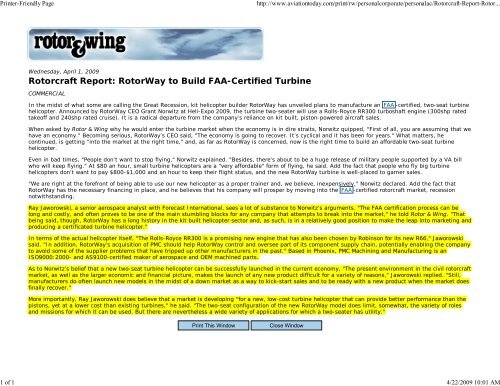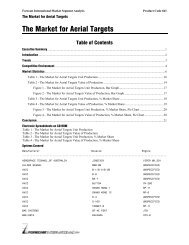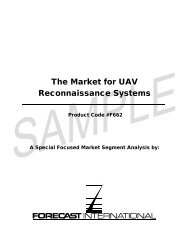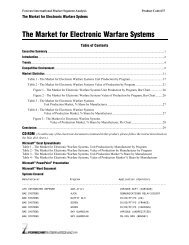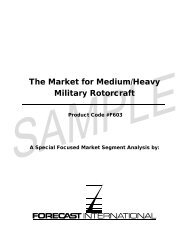RotorWay to - Forecast International
RotorWay to - Forecast International
RotorWay to - Forecast International
- No tags were found...
You also want an ePaper? Increase the reach of your titles
YUMPU automatically turns print PDFs into web optimized ePapers that Google loves.
Printer-Friendly Pagehttp://www.aviation<strong>to</strong>day.com/print/rw/personalcorporate/personalac/Ro<strong>to</strong>rcraft-Report-Ro<strong>to</strong>r...1 of 1 4/22/2009 10:01 AMWednesday, April 1, 2009Ro<strong>to</strong>rcraft Report: <strong>Ro<strong>to</strong>rWay</strong> <strong>to</strong> Build FAA-Certified TurbineCOMMERCIALIn the midst of what some are calling the Great Recession, kit helicopter builder <strong>Ro<strong>to</strong>rWay</strong> has unveiled plans <strong>to</strong> manufacture an FAA -certified, two-seat turbinehelicopter. Announced by <strong>Ro<strong>to</strong>rWay</strong> CEO Grant Norwitz at Heli-Expo 2009, the turbine two-seater will use a Rolls-Royce RR300 turboshaft engine (300shp ratedtakeoff and 240shp rated cruise). It is a radical departure from the company’s reliance on kit built, pis<strong>to</strong>n-powered aircraft sales.When asked by Ro<strong>to</strong>r & Wing why he would enter the turbine market when the economy is in dire straits, Norwitz quipped, "First of all, you are assuming that wehave an economy." Becoming serious, <strong>Ro<strong>to</strong>rWay</strong>’s CEO said, "The economy is going <strong>to</strong> recover. It’s cyclical and it has been for years." What matters, hecontinued, is getting "in<strong>to</strong> the market at the right time," and, as far as <strong>Ro<strong>to</strong>rWay</strong> is concerned, now is the right time <strong>to</strong> build an affordable two-seat turbinehelicopter.Even in bad times, "People don’t want <strong>to</strong> s<strong>to</strong>p flying," Norwitz explained. "Besides, there’s about <strong>to</strong> be a huge release of military people supported by a VA billwho will keep flying." At $80 an hour, small turbine helicopters are a "very affordable" form of flying, he said. Add the fact that people who fly big turbinehelicopters don’t want <strong>to</strong> pay $800-$1,000 and an hour <strong>to</strong> keep their flight status, and the new <strong>Ro<strong>to</strong>rWay</strong> turbine is well-placed <strong>to</strong> garner sales."We are right at the forefront of being able <strong>to</strong> use our new helicopter as a proper trainer and, we believe, inexpensively," Norwitz declared. Add the fact that<strong>Ro<strong>to</strong>rWay</strong> has the necessary financing in place, and he believes that his company will prosper by moving in<strong>to</strong> the FAA -certified ro<strong>to</strong>rcraft market, recessionnotwithstanding.Ray Jaworowski, a senior aerospace analyst with <strong>Forecast</strong> <strong>International</strong>, sees a lot of substance <strong>to</strong> Norwitz’s arguments. "The FAA certification process can belong and costly, and often proves <strong>to</strong> be one of the main stumbling blocks for any company that attempts <strong>to</strong> break in<strong>to</strong> the market," he <strong>to</strong>ld Ro<strong>to</strong>r & Wing. "Thatbeing said, though, <strong>Ro<strong>to</strong>rWay</strong> has a long his<strong>to</strong>ry in the kit built helicopter sec<strong>to</strong>r and, as such, is in a relatively good position <strong>to</strong> make the leap in<strong>to</strong> marketing andproducing a certificated turbine helicopter."In terms of the actual helicopter itself, "The Rolls-Royce RR300 is a promising new engine that has also been chosen by Robinson for its new R66," Jaworowskisaid. "In addition, <strong>Ro<strong>to</strong>rWay</strong>’s acquisition of PMC should help <strong>Ro<strong>to</strong>rWay</strong> control and oversee part of its component supply chain, potentially enabling the company<strong>to</strong> avoid some of the supplier problems that have tripped up other manufacturers in the past." Based in Phoenix, PMC Machining and Manufacturing is anISO9000:2000- and AS9100-certified maker of aerospace and OEM machined parts.As <strong>to</strong> Norwitz’s belief that a new two-seat turbine helicopter can be successfully launched in the current economy, "The present environment in the civil ro<strong>to</strong>rcraftmarket, as well as the larger economic and financial picture, makes the launch of any new product difficult for a variety of reasons," Jaworowski replied. "Still,manufacturers do often launch new models in the midst of a down market as a way <strong>to</strong> kick-start sales and <strong>to</strong> be ready with a new product when the market doesfinally recover."More importantly, Ray Jaworowski does believe that a market is developing "for a new, low-cost turbine helicopter that can provide better performance than thepis<strong>to</strong>ns, yet at a lower cost than existing turbines," he said. "The two-seat configuration of the new <strong>Ro<strong>to</strong>rWay</strong> model does limit, somewhat, the variety of rolesand missions for which it can be used. But there are nevertheless a wide variety of applications for which a two-seater has utility."Print This Window Close Window
Printer-Friendly Pagehttp://www.aviation<strong>to</strong>day.com/print/rw/military/heavylift/Heavy-Lift-U-K-Heavy-Lift-Program...1 of 3 4/22/2009 10:12 AMSunday, March 1, 2009Heavy Lift: U.K. Heavy Lift ProgramTom Withing<strong>to</strong>nCountries continue <strong>to</strong> scramble in order <strong>to</strong> supply troops in Iraq and Afghanistan with necessary search and rescue, attack and utility helicopters.The availability of medium- and heavy-lift helicopters for U.K. military operations has been a pressing issue since Great Britain began military operations in Iraqand Afghanistan. During the past eight years, British newspapers have published articles bemoaning the nation’s lack of military helicopters for intra-theatre liftin Iraq and Afghanistan with increasing frequency.However, the British Ministry of Defence (MoD) is pursuing several programs aimed at ensuring that those helicopters the Army, Royal Navy and Royal Air Force(RAF) possesses under the cross-service Joint Helicopter Command umbrella are able <strong>to</strong> provide the required lift and can cope with the harsh hot-and-highoperating conditions of Iraq and Afghanistan. At the same time, the MoD is thinking about the future composition of the U.K.’s medium- and heavy-lift militaryhelicopter force as a number of types approach the end of their service lives.Better Late Than NeverIn early 2007, the MoD announced a series of measures <strong>to</strong> revitalize the U.K. medium- and heavy-lift helicopter fleet. Six AgustaWestland EH-101 Merlinhelicopters were acquired second-hand from the Royal Danish Air Force at a cost of $341 million. Meanwhile, the RAF’s 33-strong Westland Puma HC1 fleet isexpected <strong>to</strong> receive an extensive upgrade, while the Royal Navy’s Westland Sea King HC4 medium-lift machines have received new ro<strong>to</strong>r blades. On theheavy-lift side, eight Boeing Chinook HC3 aircraft, which have yet <strong>to</strong> fly, will join the current 40-strong HC2 Chinook fleet.The AgustaWestland EH-101s (known in RAF as the Merlin HC3) aircraft are the newest addition <strong>to</strong> the RAF medium helicopter family, having arrived earlier thiscentury. The latest Danish additions are deployed with the 78 Squadron at RAF Benson air base in Oxfordshire. The base is already home <strong>to</strong> the 28 Squadron,which flies the balance of the air force’s 22-strong Merlin fleet. Since their entry in<strong>to</strong> service, the aircraft have been outfitted with forward looking infra red (FLIR)sensors, ballistic armor, machinegun pintle mounts and also a hook for underslung cargo; all as a result of Urgent Operational Requirements (UORs) for the Iraqand Afghan theatres.Benson is also home <strong>to</strong> the 33 Squadron, which flies the Westland Puma HC1. One of the oldest types in RAF service, these aircraft were delivered in the early1970s. Most recently they have been active in Iraq but the aircraft are not getting any younger. This has prompted the MoD, in collaboration with Eurocopterand British defense contrac<strong>to</strong>r QinetiQ, <strong>to</strong> perform a study on how the life of these aircraft could be extended. Any life extension program (LEP) could include newavionics, engines, communications and countermeasures. The improvements would take the service life of these aircraft <strong>to</strong> 2022; 12 years after their anticipatedretirement. In MoD parlance, the upgrade: "will address obsolescence and enable the aircraft <strong>to</strong> continue <strong>to</strong> operate effectively in a battlefield environment."What Else is NewIn terms of the engine modification, Charles Claveaux, vice president for product and market strategy at Turbomeca, specified that this could include thereplacement of the "Turmo engine with the Makila 1A1" powerplant. The Makila engine, which is standard equipment on the Eurocopter Super Puma/Cougarseries, should not be <strong>to</strong>o difficult <strong>to</strong> retrofit according <strong>to</strong> Clavaux, given the high degree of commonality between the two engine designs. "It’s relatively easy <strong>to</strong>change the engine because the design of the Makila is close <strong>to</strong> the design of the Turmo, but you have <strong>to</strong> change some parts of the helicopter because the Makilais a larger engine than the Turmo". Crucially, the Makila will give the Pumas an increase in performance: "The Makila is a 1,800 horsepower engine compared <strong>to</strong>the Turmo which is 1,500 horsepower. The fuel consumption of the Makila is 20 percent less than the fuel consumption of the Turmo. The Makila engine is areally good improvement for the helicopter. It provides some performance improvements in hot and high conditions," said Claveaux.However, as of late 2008, the British government had still <strong>to</strong> give the go-ahead for the Puma LEP, despite the fact that the aircraft continue <strong>to</strong> be heavily used bythe RAF despite their age.
Printer-Friendly Pagehttp://www.aviation<strong>to</strong>day.com/print/rw/military/heavylift/Heavy-Lift-U-K-Heavy-Lift-Program...2 of 3 4/22/2009 10:12 AMOne recent arrival <strong>to</strong> the Afghan theatre is the venerable Sea King HC4 helicopter. Originally purchased <strong>to</strong> support Royal Marine commando operations, theseaircraft have been outfitted with a new ro<strong>to</strong>r blade system that will help them cope with the challenging environment. A Carson composite main ro<strong>to</strong>r andAgustaWestland five-bladed tail ro<strong>to</strong>r were installed, tested and deployed in only 12 months after a UOR from the MoD. The program cost $10.1 million.According <strong>to</strong> Malcolm Tier, QinetiQ business group manager for rotary wing evaluation services at MoD Boscombe Down, "The Carsen blade project will enable theaircraft <strong>to</strong> operate in theatres which were hither<strong>to</strong> unavailable <strong>to</strong> it. You can take the old blades off and put the new ones on and you get a vast increase incapability. The big problem about operating the Sea Kings in Afghanistan is the country’s height above sea level. The air is much thinner and the drop-off interms of lift and forward speed is significant. The Carson blade is enabling the aircraft <strong>to</strong> operate at its operational and design capability at higher altitudes." TheMoD is now also looking at whether the Sea King’s life can be extended <strong>to</strong> 2017. However, before then the U.K. MoD is expected <strong>to</strong> launch the Future MediumHelicopter program that could see the acquisition of up <strong>to</strong> 60 medium-lift machines <strong>to</strong> replace the Sea Kings and Pumas.More <strong>to</strong> ComeIn 1995, the MoD purchased eight Chinook HC3 helicopters from Boeing <strong>to</strong> support special forces operations. However, since their delivery between 2001-2002they have languished on the ground unable <strong>to</strong> fly until some undisclosed technical issues are resolved. That these highly capable machines have been groundedhas caused something of a minor national scandal in the U.K., particularly at a time when helicopter lift has been in such demand. The purchase cost the Britishtaxpayer $491 million and the acquisition was described by the House of Commons Public Accounts Committee as one of the "worst examples of equipmentacquisition."The aircraft were allegedly grounded because of problems relating <strong>to</strong> the certification of their hybrid digital-analogue flight controls. However, Boeing will not bedrawn on the reasons why, "That’s a really difficult question. It’s a really sensitive issue with the Boeing Company" said Ed Palek Boeing chinook Mk.3 reversionprogram manager.The aircraft will be returned <strong>to</strong> flight, with all eight in service by 2010 following a $261 million reversion program. This will put the <strong>to</strong>tal acquisition price for theaircraft around $682 million, making these eight Chinooks the most expensive helicopters that the MoD has ever purchased. Boeing is the prime contrac<strong>to</strong>r forthe Chinook revitalization, "We’re responsible for the design, development, modification and test of those eight aircraft as we go through this capabilitymodification and bring the aircraft <strong>to</strong> a suitable flight status" remarked Palek. "The eight Chinooks will receive some changes; modifications <strong>to</strong> the cockpitdisplays and the introduction of a health and usage moni<strong>to</strong>ring system."In terms of the other Chinooks operated by the RAF, the MoD launched Project Julius in Oc<strong>to</strong>ber 2008, as an initiative <strong>to</strong> roll out an improvement package thatincludes digital avionics integration and an upgrade for the type’s Honeywell engine <strong>to</strong> T55-714 status. Other modifications include the addition of GeneralDynamics Bowman radios and the Raytheon Successor Identification Friend or Foe system. Project Julius will be rolled out across the entire Chinook force,including the eight special forces’ machines undergoing the reversion work. This will enable the Chinook fleet <strong>to</strong> remain in service until around 2040. This is animportant consideration given that RAF Chinook operations in Afghanistan have increased by 25 percent since May 2008.Palek noted that the U.K. MoD, "Has found upgrades <strong>to</strong> be a very cost-effective alternative <strong>to</strong> going forward and adapting new airframes." Upgrades also help <strong>to</strong>defer the cost of purchasing new helicopters, notwithstanding the six Merlins bought from Denmark. That said, the combined medium- and heavy- lift helicopterforce would dip from its present 132 aircraft <strong>to</strong> 97 machines in 2017 with the Sea King retirement and <strong>to</strong> 64 aircraft in 2023 once the Pumas are withdrawn.The Future of the LiftWith no further medium-lift helicopter purchases during the next 10 years, the fleet size in 2025 could be under 60 percent of <strong>to</strong>day’s inven<strong>to</strong>ry. Given theprotracted nature of defense acquisition, particularly of aircraft, the MoD will have <strong>to</strong> start thinking soon about the future medium helicopter if it is <strong>to</strong> ensure thatnew helicopters are in service as the Sea Kings and Pumas leave service. However, as noted below, the economic outlook for the U.K. is bleak for the moment.Moreover, the government has <strong>to</strong> call a general election before June 2010 and the governing Labour party may wish <strong>to</strong> defer large defense purchases when it willno doubt be looking <strong>to</strong> score political points with voters by keeping taxes down.While British operations in Iraq may have concluded by then, new unexpected crises may have flared up, not <strong>to</strong> mention additional contingencies in other partsof the world <strong>to</strong> which British forces may be asked <strong>to</strong> respond. Moreover, the U.K.’s combined military helicopter fleet could reduce in size by 40 percent duringthe next 15 years and future helicopter purchases or upgrade programs could be stymied by the U.K.’s poor economic outlook, with the country having beendeclared officially in recession in late January. While few would doubt the aplomb with which the U.K.’s medium- and heavy-lift helicopter fleet have operated inIraq and Afghanistan, during the next few years they may not only face challenges from hostile action but also from the financial pressures that could grip theBritish treasury.
Printer-Friendly Pagehttp://www.aviation<strong>to</strong>day.com/print/rw/military/heavylift/Heavy-Lift-U-K-Heavy-Lift-Program...3 of 3 4/22/2009 10:12 AMShow Me the MoneyBy James Careless<strong>Forecast</strong> <strong>International</strong>’s research expects that 3,924 new-build medium/heavy military ro<strong>to</strong>rcraft will be produced from 2009 through 2018. "The value of thisproduction, in constant FY09 U.S. dollars, is estimated at $88.1 billion," said the study.The ro<strong>to</strong>rcraft covered by this market include non-U.S. products, like the NH Industries NH90 and the Korea Aerospace Industries Korean utility helicopter, plusthe new UH-60M variant from Sikorsky’s Black Hawk line, the CH-47F model from Boeing’s Chinook family and the Bell/Boeing V-22 tiltro<strong>to</strong>r.The study says Sikorsky will remain the market leader during 2009-2018 in unit production and value of production. "Sikorsky is expected <strong>to</strong> produce 1,478helicopters for a sizable market share of 37.7 percent," it stated. "NH Industries is ranked second in unit production with forecast production of 569 NH90s,representing a 14.5 percent share of the market." This number does not include 51 NH90s that <strong>Forecast</strong> <strong>International</strong> believes will be built under license byFinnish manufacturer Patria Aviation.As for the all-important dollar value? "Sikorsky garners a 32.2 percent share of production, worth $28.3 billion," according <strong>to</strong> the study. "Second place goes <strong>to</strong>the Bell/Boeing V-22 partnership, with production worth $21.5 billion, a share of 24.4 percent. Third is NH Industries, with an 11.5 percent share of productionvalued at $10.1 billion."Given these <strong>to</strong>tals, it is clear that <strong>Forecast</strong> <strong>International</strong>’s warning about the U.S. losing market share is not an imminent one; at least not in terms of animmediate collapse. However, the possibility of this happening over time as non-U.S. manufacturers increase their percentages is worth paying attention <strong>to</strong>.After all, there was a time when GM was America’s largest au<strong>to</strong>maker. Now it’s Toyota.Print This Window Close Window
Printer-Friendly Pagehttp://www.aviation<strong>to</strong>day.com/print/rw/military/heavylift/Ro<strong>to</strong>rcraft-Report-U-S-Losing-Medi...1 of 2 4/22/2009 10:13 AMSunday, March 1, 2009Ro<strong>to</strong>rcraft Report: U.S. Losing Medium/Heavy Military SalesJames CarelessNEWSU.S. medium/heavy military helicopter manufacturers are losing ground <strong>to</strong> foreign competi<strong>to</strong>rs, precisely because U.S. manufacturers have concentrated ongiving the Pentagon what it asked for. That’s the conclusion of a new <strong>Forecast</strong> <strong>International</strong> study entitled, "The Market for Medium/Heavy Military Ro<strong>to</strong>rcraft -2009-2018."Here’s how pleasing the Pentagon is working against U.S. manufacturers: "In recent years, when the U.S. military has gone <strong>to</strong> buy ro<strong>to</strong>rcraft, they haveconcentrated on improved versions of helicopters already in their fleet," said study author Ray Jaworowski in an exclusive interview with Ro<strong>to</strong>r & Wing. To meetthis demand, U.S. medium/heavy manufacturers have put their efforts in<strong>to</strong> updating current models rather than developing brand new helicopters. "The result istheir product lines for military aircraft are composed of derivatives, going up against new designs from Europe and Asia," he said.This wouldn’t matter if the Pentagon stuck <strong>to</strong> buying U.S. products, as has been the case in the past. "But in the last few years, the U.S. military has opened upthe U.S. platform market essentially <strong>to</strong> all comers," Jaworowski said. "As we saw with the LUH program and the presidential transport, the U.S. military is nowwilling <strong>to</strong> buy helicopters from non-U.S. manufacturers."This has put U.S. medium/heavy manufacturers in a "weird Catch-22," he noted. By providing the Pentagon with the derivatives it has requested — in an effort<strong>to</strong> enhance fleet harmonization and control development costs — U.S. manufacturers have put themselves at a competitive disadvantage for Pentagon contracts."Ironically, since the U.S. military market is no longer a captive market for domestic manufacturers, the U.S. military is now willing <strong>to</strong> buy from non-U.S.manufacturers," Jaworowski noted.The result is that non-U.S. manufacturers are getting traction in the U.S. military market, and improving their competitive position globally. This is not goodnews, given how high the stakes are for helicopter manufacturers. "In terms of dollar revenue, medium/heavy military ro<strong>to</strong>rcraft constitute the largest segmen<strong>to</strong>f the overall ro<strong>to</strong>rcraft market," the <strong>Forecast</strong> <strong>International</strong> study warned. "It is this segment where manufacturers compete for the most lucrative contracts inthe ro<strong>to</strong>rcraft industry. Thus, it is no coincidence that the medium/heavy military sec<strong>to</strong>r is seeing an influx of new models, production of which will help expandand then stabilize yearly output in the segment."In his study, Jaworowski cited Sikorsky as being the world’s dominant medium/heavy military helicopter manufacturer. So what does Sikorsky think of <strong>Forecast</strong><strong>International</strong>’s report? "I don’t agree completely with these market share conclusions," replied Sikorsky spokesman Paul Jackson. "New development programsentail risk that could eventually hurt market share, while upgrades can generally get products <strong>to</strong> market much faster. I believe Black Hawk and Seahawkhelicopters will continue <strong>to</strong> hold solid market share through FMS sales, and with new products such as the Armed Battle Hawk and the international Black Hawkcontinuing <strong>to</strong> progress <strong>to</strong>ward production, the market share for the overall Hawk line should be poised for future growth. I also would cite the S-92 and H-92programs, as well as the CH-53K development program, as examples of successful upgrade programs with solid market growth prospects."As for other helicopter manufacturers, NH Industries did not acknowledge repeated requests for interviews, while Boeing did but declined <strong>to</strong> comment. ButKaman Aerospace was willing <strong>to</strong> talk. "Undoubtedly there is a serious threat with Russia consolidating their helicopter industry and the growth potential of Indiaand China," said Mark Tattershall, Kaman’s direc<strong>to</strong>r of marketing and business development. Part of the threat <strong>to</strong> U.S. medium/heavy helicopter manufacturerscomes from their willingness <strong>to</strong> transfer technology <strong>to</strong> non-U.S. companies; an advantage that non-U.S. companies then use <strong>to</strong> compete in the U.S. militarymarket, he said. "In my opinion, American manufacturers should be very reluctant <strong>to</strong> transfer technology overseas."Tattershall also said that U.S. manufacturers must be willing <strong>to</strong> invest in R&D <strong>to</strong> keep up with foreign manufacturers in the global marketplace. "We needcollectively <strong>to</strong> ensure that research and development budgets are sufficient <strong>to</strong> maintain our competitive edge," he <strong>to</strong>ld Ro<strong>to</strong>r & Wing. "Defense exports are one ofthe few major success s<strong>to</strong>ries that the U.S. has got."
Printer-Friendly Pagehttp://www.aviation<strong>to</strong>day.com/print/rw/military/heavylift/Ro<strong>to</strong>rcraft-Report-U-S-Losing-Medi...2 of 2 4/22/2009 10:13 AMThe bot<strong>to</strong>m line: <strong>Forecast</strong> <strong>International</strong>’s study points <strong>to</strong> a very real vulnerability in the U.S. helicopter sec<strong>to</strong>r trying <strong>to</strong> ride out a recession. "Measured by dollarvolume (though not by units produced), the medium/heavy military class is easily the largest segment of the ro<strong>to</strong>rcraft market," the study said. "Near-termgrowth and longer-term stability in this segment will help ro<strong>to</strong>rcraft manufacturers survive through what may be difficult times in the civil side of the ro<strong>to</strong>rcraftmarket in the next few years."This is why losing ground in this market matters so much <strong>to</strong> U.S. manufacturers. With the civil side cooling down, reliable military revenues are more importantthan ever.Print This Window Close Window
Printer-Friendly Pagehttp://www.aviation<strong>to</strong>day.com/print/rw/military/attack/Ro<strong>to</strong>rcraft-Report-Bright-Future-for-Lig...1 of 1 4/22/2009 10:14 AMMonday, December 1, 2008Ro<strong>to</strong>rcraft Report: Bright Future for Light Military HelicoptersNEWSThe New<strong>to</strong>wn, Conn-based aerospace market analysis firm, <strong>Forecast</strong> <strong>International</strong> (FI), concluded its three-month study of the helicopter industry anddetermined light military helicopters will be the most dynamic sec<strong>to</strong>r worldwide for the ro<strong>to</strong>rcraft market.FI’s data, which they gather on an annual basis, indicates production of light military helicopters will double in the next several years, rising steadily fromapproximately 132 units in 2008 <strong>to</strong> 291 in 2014.The study lists several fac<strong>to</strong>rs that are driving those numbers, including the intention of the U.S. Army <strong>to</strong> acquire additional aviation assets, such as the UH-72Lakota and a new armed reconnaissance helicopter designed <strong>to</strong> take the place of Bell’s ARH offering that was cancelled in September 2008 due <strong>to</strong> delivery andcost overruns.In a conversation with Ro<strong>to</strong>r & Wing, Raymond Jaworowski, FI’s senior aerospace analyst, cautioned that the study defines a light helicopter as having amaximum gross weight of less than 15,000 lb. The Federal Aviation Administration defines them as weighing less than 6,000 lb."It’s arbitrary," Jaworowski said of the 15,000 lb definition. "Generally what we’re trying <strong>to</strong> do is place ro<strong>to</strong>rcraft in a category that makes sense <strong>to</strong> us from amarket evaluation point of view, so we use 15,000 lb as a guide line."Although FI’s forecast for light helcopters is bright, other industry observers wonder if U.S. troop standdowns in the Middle East, such as those suggested byPresident-elect Barack Obama during his campaign, will affect those figures.Print This Window Close Window
Printer-Friendly Pagehttp://www.aviation<strong>to</strong>day.com/print/rw/<strong>to</strong>ps<strong>to</strong>ries/Firm-Sees-Pis<strong>to</strong>n-Production-Tailing-Off_22...1 of 1 4/22/2009 10:18 AMFriday, June 20, 2008Firm Sees Pis<strong>to</strong>n Production Tailing OffThe market analysis firm <strong>Forecast</strong> <strong>International</strong> sees pis<strong>to</strong>n-powered helicopter production <strong>to</strong> taper off in coming years. Production in that category has beenbooming since 2002, when only about 290 units were built, said Ray Jaworowski, senior analyst for the New<strong>to</strong>wn, Conn.-based firm. He expects nearly 800 pis<strong>to</strong>nhelicopters <strong>to</strong> be built this year. After that, “we expect that pis<strong>to</strong>n output will gradually decline <strong>to</strong> more sustainable levels.” A key reason is the advent of new,low-cost single-engine turbines like the Robinson Helicopter R66 and the Schweizer Aircraft 434. “We also expect we'll eventually see a new single turbine fromBell <strong>to</strong> replace the B3 Jet Ranger, which is being taken out of production.” For related newsPrint This Window Close Window


